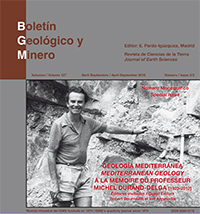Important geosites and parks in the UNESCO World Heritage Site of the Dolomites
DOI:
https://doi.org/10.21701/bolgeomin.127.2-3.027Keywords:
Permian/Triassic boundary, geotourism, Dolomites, education, stratigraphy, paleogeographyAbstract
In the geological complexity of the south Tyrol, the Dolomites play a fundamental role, as they are now included in the UNESCO World Heritage (2009) because of their exceptional beauty and unique landscape, together with numerous scientific discoveries. The name of Dolomite comes from the famous mineral dolomite (double calcium magnesium carbonate) discovered by Déodat De Dolomieu in 1789. The dolomitic rocks constitute a large area of the Triassic mountains and many studies have contributed to the discovery of the fundamental stratotypes for the signature of the Permian/Triassic boundary. The steep walls of the Permian volcanic formations and the Sciliar Mountain have always been a great attraction for scientists from all over the world to study the open book of nature in the Dolomites.
We will illustrate three sites:
1. The Bula Geotrail. A geological trail through one of the best-preserved sedimentary series in which we can observe one of the most important stratotypes to touch the Permian/Triassic boundary.
2. The Siusi-Alpe di Siusi Geological Trail. This trail starts just above the Permian/Triassic boundary and is characterized by some unique basaltic columnar formations and other significant outcrops of Lower and Medium Triassic.
3. The Bletterbach Geopark. In this sequence the stratotype, which represents the boundary, is a dark coloured continuous layer (organic matter) 5cm thick, and contains some paleobotanical evidence which is unique in the world.
The preservation and added value of the natural and geological patrimony of a region through guided and documented trails are at the origin of a new kind of tourism: geotourism. The modern tourist is more and more interested and stimulated by getting to knowing nature in depth. The trails are the best instruments for scientific divulgation and education, allowing a better understanding of the landscape and stimulating new discoveries.
Downloads
References
Avanzini, M. and E. Kustatscher, E., 2011. La Gola del Bletterbach: Storie nella roccia - Ed. Centrovisite GEOPARC Bletterbach - pp. 68.
Bosellini, A. 1996. - Geologia delle Dolomiti.
Brandner, R. and Kiem, L., 2011. A 4 day Geologic field trip in the Western Dolomites, pg. 76-118. Geo. Alp Journal Vol. 8.
Brandner, R., and L. Kiem, L., 2011. Geotrail Bula-Pufels-Bulla. Provincia Autonoma di Bolzano Ed.
Brandner, R., et al. - 2009 - The Pufels/Bulla road section: deciphering environmental changes across the Permian-Triassic to the Olenekian by integrated litho-, magneto- and isotope stratigraphy. A field trip guide, pg 116-132 - Geo.Alp Vol.6.
Farabegoli e E. Tonidandel, D., 2012. Stratigrafia e facies al limite Permiano-Triassico nelle Dolomiti Occidentali (Provincia di Bolzano, Italia): una revisione, pg.120-155 - Geo.Alp Vol. 9.
Downloads
Published
How to Cite
Issue
Section
License
Copyright (c) 2024 Consejo Superior de Investigaciones Científicas (CSIC)

This work is licensed under a Creative Commons Attribution 4.0 International License.
© CSIC. Manuscripts published in both the print and online versions of this journal are the property of the Consejo Superior de Investigaciones Científicas, and quoting this source is a requirement for any partial or full reproduction.
All contents of this electronic edition, except where otherwise noted, are distributed under a Creative Commons Attribution 4.0 International (CC BY 4.0) licence. You may read the basic information and the legal text of the licence. The indication of the CC BY 4.0 licence must be expressly stated in this way when necessary.
Self-archiving in repositories, personal webpages or similar, of any version other than the final version of the work produced by the publisher, is not allowed.















